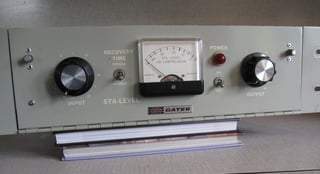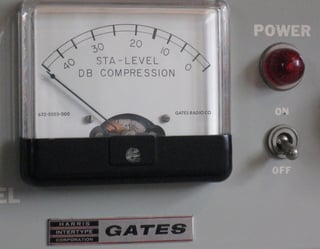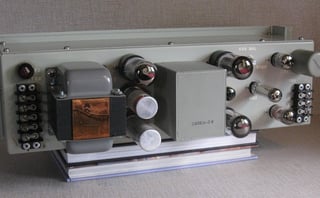Vintage Audio: The Sta-Level Turns 60 | Telos Alliance
By The Telos Alliance Team on Mar 28, 2016 11:30:00 PM
 Vintage Audio: The Sta-Level Turns 60
Vintage Audio: The Sta-Level Turns 60
As a teenager coming of age in the late '60s and early '70s, I went on nickel tours of every radio station I could. Some of them twice. One piece of equipment that almost every station had was a Gates Sta-Level AGC amplifier. It's safe to say that this device dominated the sound of Top 40 radio from the 1960s through the early '70s. Introduced sixty years ago, in 1956, Gates sold them by the boatload.
Typically, the Sta-Level was located in the studio, and its output was connected to equalized telephone lines. From there, the audio went on to the transmitter site. Occasionally they were sighted in production rooms too. Any place you needed to even out erratic audio levels, you could find the ubiquitous Sta-Level. A testament to the popularity of this device is the fact that many of today's software-based audio processing devices have a Sta-Level plug-in. Used Sta-Levels still command high prices when they appear on eBay. Also, Retro Instruments sells a reproduction of the venerable Gates device.
While the Sta-Level, its operation, and circuitry are well known, the story of how it came into existence is less so. This installment of Found in the Attic looks at the Gates Sta-Level, and in particular, its historical origins.
All vintage tube limiters work pretty much the same way. You start with a high-gain amplifier, giving enough juice so that a sample of the output signal can be easily rectified and sent back to an earlier stage, usually used as a bias signal. A lot of the 'magic' to the Sta-Level sound comes from the gain control circuit. The rectified control voltage from a 6AL5 was sent to the grids of the 6386 variable mu stage. It was the 6386 that really provided the unique sound. But the Gates Sta-Level was not the first audio limiter to use this tube. And that is where this story becomes interesting.
The 6386 was a variable mu remote cutoff triode that was developed by General Electric. These remarkable tubes had gold-plated grids, and a very long life. Even near the end, they never lost their amazing linearity.
The broadcast division of General Electric developed the BA-9 B, better known as the Uni Level AGC amp in 1955 to exploit the qualities of the 6386. The Uni Level worked well, but it was a totally stripped-down device. Input and output levels were set by fixed resistor pads that the user installed on terminal boards. There was no gain reduction meter, although there were instructions in the manual on how to add one using a VU meter with a decal. Gain recovery could be changed by soldering a jumper across a 10 Meg resistor. There were only five tubes in the circuit: the 6386 input/gain control tube, a pair of 6V6s providing push-pull output, the 6AL5 bias rectifier, and the 5Y3 rectifier.
When the engineers at Gates saw the Uni Level, they wanted a piece of the action. Of course, the circuit that gave the Uni Level such a great sound was patented by GE. The challenge for Gates was to build a circuit that did the same thing in a way sufficiently different to dodge a patent suit.
This was accomplished by adding an additional amplifier stage after the 6386. That 12AT7, V2 on the schematic, is totally superfluous. The added gain is totally swamped out by feedback. In fact, one of the underground mods that circulated back in the day was to remove V2 and couple the plates of the 6386 directly to the grids of the 6V6s with a .5 uf or greater mylar or paper capacitor. One less amplification stage equals less noise and distortion. Gates also added an OB2 voltage regulator to provide a stiff bias of 25 volts to the 6AL5, setting a threshold for AGC action to take place.
Compared to later AGC amps, there was relatively little you could do to tailor the sound of the Sta-Level. Mostly, it was a matter of changing the compression ratio and release time. Top 40 stations, seeking a more aggressive sound, would run the Sta-Level with a much higher compression ratio and faster release time. MOR stations would do the opposite.
Out of the box, Sta-Level would recover 2/3 of level in seven seconds, and 90 percent in 28 seconds. Included with Sta-Level was a baggie full of resistors with instructions on how to make this longer or shorter by changing the values of R36 and R37. On the fast side, it could go up to 2 ¼ seconds for 2/3 level and 10 seconds for 90 percent level. Want to slow it down a bit? How about 11 seconds for 2/3 level and 45 seconds for 90 percent level. There was also the front panel switch to select single or double attack and release time.
The marketing strategy for the Sta-Level included adding in all those features that were left out of the Uni Level. Variable input and output controls, a gain reduction meter, and adjustable recovery time were part of the package. The plan worked, and soon Sta-Levels were everywhere, while the GE Uni Level was seldom sighted.
While the Sta-Level represented a great leap forward in terms of affordable audio processing, it was not perfect. With no signal input, the device would release to maximum gain, bringing up all the system hum and noise. Gates remedied this problem with their next AGC amp, the Level Devil. It featured a gating circuit which would freeze the gain reduction when there was a loss of audio. Level Devil worked well, but was never as popular as the Sta-Level.
These two devices marked the end of tube type AGC amps in the Gates product line. Both were phased out in the 1970s to make room for the Solid Statesman line of AGC and limiter amps.
While the Sta-Level had more features than the Uni Level, the truth is that both units were built for a low price point, rather than high quality. The 6386 gain reduction circuit was probably taken to its highest level in some of the scratch-built limiters that station engineers put together. For them, the schematic of the Sta-Level was only a jumping off point.
Whereas the Sta-Level only used voltage regulation to set bias for the 6AL5, a better scheme was to regulate all plate voltages. The plate voltage on the 6386 should not be allowed to change as high level audio signals modulate the plate supply of the amplifier. A common scheme on these homemade Sta-Levels was to use a series regulator such as a 6AS7 with a 6SJ7 DC amplifier along with a VR tube such as the OB2. This circuit would regulate the plate voltage of the 6V6 output stage, and provide a lower voltage for the 6386.
A big area for improvement was the use of better components. The audio transformers were a good place to start. Gates used Triad devices, which met broadcast-quality specs, but UTC premium quality devices gave better performance. Carbon or metal film resistors for the grids and higher quality capacitors were also in order.
Another enhancement involved adding a pot to vary the DC bias on the 6386 cathode. This would establish a porch which would limit the range over which gain reduction would occur. The end result was a device that wouldn't su ck up noise to program level during quiet passages. This was probably not as necessary for stations with a Top 40 format, but essential for those playing classical or jazz music. It also worked well for processing television audio back in the day, when the noise on the audio tracks of 16 and 35 mm film could also get boosted to annoying levels during dramatic pauses.
ck up noise to program level during quiet passages. This was probably not as necessary for stations with a Top 40 format, but essential for those playing classical or jazz music. It also worked well for processing television audio back in the day, when the noise on the audio tracks of 16 and 35 mm film could also get boosted to annoying levels during dramatic pauses.
This Sta-Level was cast off from a college radio station in the mid-1980s. The date code on some of the capacitors suggest that it was made around 1967-68, after the paint scheme went from the original medium gray to light beige, and the old Gates logo was replaced by that of the newer Gates/Harris Intertype Corporation regime. It is in working condition, although without any of the aforementiond tweaks or mods. It shares a space on the home office bookshelf with another FitA subject, the Wilkinson GCA-1 AGC amp. The two make an interesting pair to display, because the Wilkinson unit is as obscure as the Gates is well-known.
Telos Alliance has led the audio industry’s innovation in Broadcast Audio, Digital Mixing & Mastering, Audio Processors & Compression, Broadcast Mixing Consoles, Audio Interfaces, AoIP & VoIP for over three decades. The Telos Alliance family of products include Telos® Systems, Omnia® Audio, Axia® Audio, Linear Acoustic®, 25-Seven® Systems, Minnetonka™ Audio and Jünger Audio. Covering all ranges of Audio Applications for Radio & Television from Telos Infinity IP Intercom Systems, Jünger Audio AIXpressor Audio Processor, Omnia 11 Radio Processors, Axia Networked Quasar Broadcast Mixing Consoles and Linear Acoustic AMS Audio Quality Loudness Monitoring and 25-Seven TVC-15 Watermark Analyzer & Monitor. Telos Alliance offers audio solutions for any and every Radio, Television, Live Events, Podcast & Live Streaming Studio With Telos Alliance “Broadcast Without Limits.”
More Topics: Vintage Radio Technology
Recent Posts
Subscribe
If you love broadcast audio, you'll love Telos Alliance's newsletter. Get it delivered to your inbox by subscribing below!